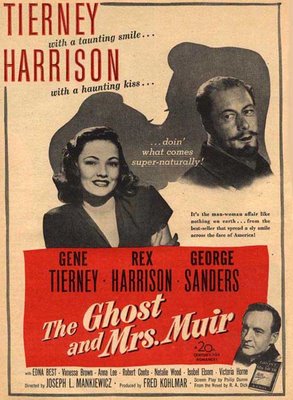
Nora's Nite
Special Guest: Lisa!
Indian Food, Lemon meringue Pie
For the first time in MovieNite history, Nora forgets about dessert and actually needs a "hint."
Glenn Erickson via DVDSavant:
Most escapism of the time would instantly prescribe a man for what ails Lucy, or better, lots of men. That's where The Ghost and Mrs. Muir deviates from the norm. Captain Gregg is good company at the odd times when he's there, but he's not flesh and blood and both of them know that's what Lucy (or Lucia, as Gregg calls her) needs. There's a sadness about Lucy's life that stays hidden beneath the surface of the film. In less glamorous surroundings, this could be a tale of isolation and estrangement.It almost is. Lucy's romance with the ghost clearly has no sex angle, just the thrill of being worshipped by a handsome lover. So the audience gets the soulful romance without the sex. It's just the kind of masochistic thrill that became popular in soapy 50s pictures.
But there are some interesting twists. In a terrific scene with the wonderful Anna Lee, Lucy finds herself the "other woman" in a faithless triangle. The sobering novelty of the moment places no satisfaction in adultery, the foundation of many a Hollywood potboiler. Muir's yearning for her married beau dissolves as soon as she finds out the truth. Refreshingly, the story places the blame with the wayward and deceitful man, and notes a sad but unspoken bond between the wronged women.
All of Lucy's real relationships are with other women, with her maid as the only lasting one. Her daughter Anna (initially a cute Natalie Wood) has her own life to lead and as such becomes as remote as the rest of the world that Lucy has turned her back against. Both the maid and Anna have vague memories of hearing and seeing Captain Gregg too, a nice touch.
The Ghost and Mrs. Muir is in some ways a female Vincent Price movie, an "Ellen Allan Poe" picture. Like a Poe character, Muir lives in isolation, indulges in delirious fantasies, has disastrous relationships in the outside world and obsesses over lost loves real and imagined. It's all from a distinctively female perspective, however. Time has a different meaning - Muir is less rushed and less desperate in her actions than a Poe protagonist. When the years make her gray and rot the wood down on the beach, there's a crushing dread involved, a feeling of loss and perhaps waste. But it's a natural feeling derived from life and not some supernatural curse of guilt or honor. The mature philosophy here is contrary to Poe's fated morbidity. People get old and lonely and they die, and life moves on. It's supposed to be that way.
Philip Dunne vis Wikipedia:
Philip Ives Dunne was born in New York City, the son of Chicago syndicated columnist Finley Peter Dunne and Margaret Ives (Abbott) Dunne, the daughter of the Chicago Tribune's book reviewer and novelist, Mary Ives Abbott.Although a Roman Catholic, he attended the Middlesex School (1920-1925) and Harvard University (1925-29). Immediately after graduation, he boarded a train for Hollywood. His first screenplay (uncredited) was Me and My Gal, released in 1932. His first credited screenplay was The Count of Monte Cristo, released in 1934. After working for various studios, he moved to 20th Century Fox in 1937, where he would remain for 25 years (excepting 4 years civilian war service during World War II), scripting 36 films in total and directing 10. He also produced several of his later films.
Dunne was a co-founder of the Screen Writers Guild and served as vice-president of its successor, the Writers Guild of America from 1938 to 1940 . He later served on the Board of Governors of the Academy of Motion Picture Arts and Sciences (AMPAS), from 1946 to 1948.
Before World War II, he was a member of the Committee to Defend America by Aiding the Allies, a group founded in May, 1940, that advocated military materiel aid to Britain as the best way to keep the United States out of the war.
From 1942 to 1945, Dunne was the Chief of Production for the Motion Picture Bureau, U.S. Office of War Information, Overseas Branch; notably, he produced the non-fiction short The Town (1944), directed by Josef von Sternberg, which has received some critical acclaim.In 1947 he co-founded the Committee for the First Amendment to protest the House Un-American Activities Committee's (HUAC) investigation of Communist influence in Hollywood. He appeared before HUAC with other Hollywood figures in a well publicized meeting in October 1947.
Dunne received two Academy Award nominations for screenwriting: How Green Was My Valley (1941) and David and Bathsheba (1951). He also received a Golden Globe nomination for his screen adaptation of Irving Stone's novel The Agony and the Ecstasy (1965), as well as several peer awards from the Writer's Guild of America (WGA).
Dunne married the former Amanda Duff on July 13, 1939; they had three children, Miranda, Philippa, and Jessica.
In 1980 he published his memoirs, Take Two: A Life in Movies and Politics.
Dunne died of cancer on June 2, 1992 in Malibu, California
The 1992 film The Last of the Mohicans, directed by Michael Mann and starring Daniel Day-Lewis, was based on Dunne's 1936 screenplay of the Fenimore Cooper novel.


1 comment:
the dessert moment was priceless!
Post a Comment